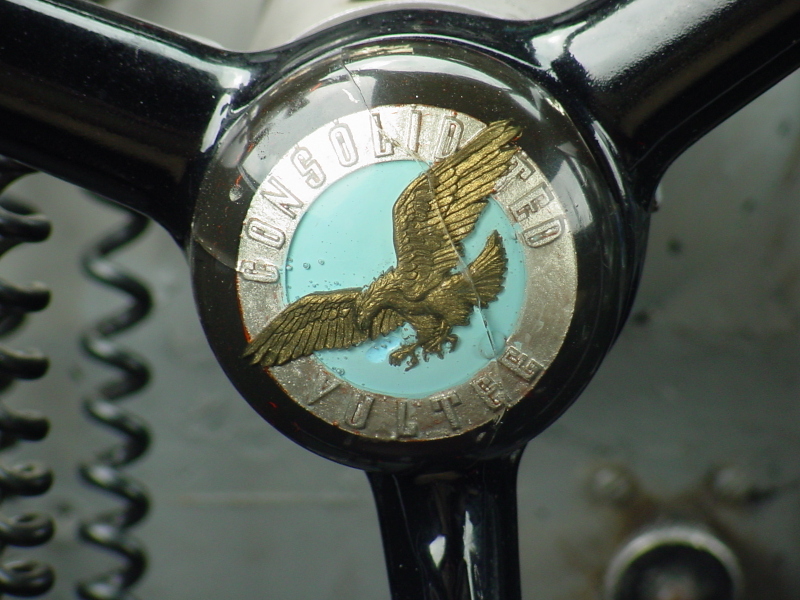| Prev |
heroicrelics.org Diamond Lil Site Index B-24 Interior Gallery |
Next |
dsc19393.jpg
Emblem on center of pilot's control wheel.
Seeing the name "Consolidated Vultee" (usually the B-24 is just referred to as a "Consolidated" plane) reminded me that Consolidated eventually became Convair, manufacturer of the Atlas missile. The Atlas was America's first ICBM. Converted versions of this missile were used to launch many of the early probes to the moon, Mars, and Venus, and the Atlas D was used in Project Mercury to orbit John Glenn and three other astronauts.
From Chuck Walker's Atlas: The Ultimate Weapon:
Convair grew from a Buffalo, New York-based airplane manufacturer. Major Reuben Fleet, ex-head of the Air Mail service and a pilot with military training and many flight hours, established the Consolidated Aircraft Corporation (CAC) in May, 1923.
CAC produced a variety of airplanes for the military and for private and commercial buyers. Mac Laddon, Fleet's chief designer, designed a two-engine flying boat, the XPBY Catalina, which was ordered in quantity by the Navy. Because flying boats and float airplanes required a year-round waterway, Fleet started looking around for an all-weather, all-year location to produce seaplanes (the weather in Buffalo certainly did not fit the requirement).
Fleet chose San Diego for CAC's new plant, which was dedicated in 1935. The plant was built on the north side of San Diego's main airport, Lindbergh Field, near the west end. . . . The plant had access to San Diego harbor right across the field.
During the next few years, CAC built a variety of airplanes. As the war loomed, CAC designed and built the PB2Y-3 and PB4Y-2 [I assume the "PB4Y-2" reference is a typo in the book. The PB4Y-2 "Privateer" was a version of the B-24 with single vertical stabilizer built for the Navy; I assume the author really meant "PB2Y-4", which was an updated version of the -3] flying boats and presented such believable data on a long-range four-engine heavy bomber that CAC received a production order for seven B-24 bombers one week before the order for the one mockup and one prototype was placed. The first B-24 bomber flew successfully one day earlier than the nine-months-after-award delivery specified by the contract.
In the early years of World War II, the government built a companion plant about two miles north of Plant 1, as the CAC Lindbergh Field plant was known. The new plant, officially designated USAF Plant 19 but commonly referred to as Plant 2, was used exclusively to produce B-24s and other military aircraft. A total of 19,256 B-24s were built during the war at four major CAC plants - the San Diego facilities, the mammoth Ford Motor Company Willow Run plant in Michigan, and in the Tulsa and Ft. Worth assembly plants. The last B-24 rolled off the line on May 31, 1945.
Fleet had built CAC into a manufacturing giant, far too large for one person to handle. Aviation Corporation (AVCO), through its Vultee Aircraft Corporation subsidiary, bought out Fleet's controlling interest of 34% of CAC's stock on December 19, 1941. The merger was completed in March, 1943, and CAC became Consolidated Vultee Aircraft Corporation (CVAC, sometimes translated by less-serious company employees as "Christ, Ve Are Confused"), and later converted to the acronym "Convair."
Convair had some financial problems after World War II as airplane production phased down. . . .
In 1953, John Jay Hopkins, Chairman of General Dynamics (GD), acquired Convair. No obvious changes occurred in the day-to-day activities of the programs underway. However, GD's size, and the goals and quality of its leadership, lent considerable support and strength to the work underway by Convair. The melding produced a new name -- Convair, a Division of General Dynamics, shortened to the GD/Convair.
So, if the B-24A model was manufactured in 1939 (well before the merger), this emblem is certainly not original equipment. However, according to the Commemorative Air Force's Diamond Lil history page, the plane was used as a "company aircraft," so the emblem was likely added then.
Of course, the CAF folks might think it looks as cool as I do, and may have added it as "after-market" equipment.

| Time picture taken | Sun Aug 6 12:33:52 2006 |
| Location picture taken | Northwest Chicago International Airport at Rockford (RFD) Rockford, IL |
| Prev | B-24 Interior Gallery | Next |